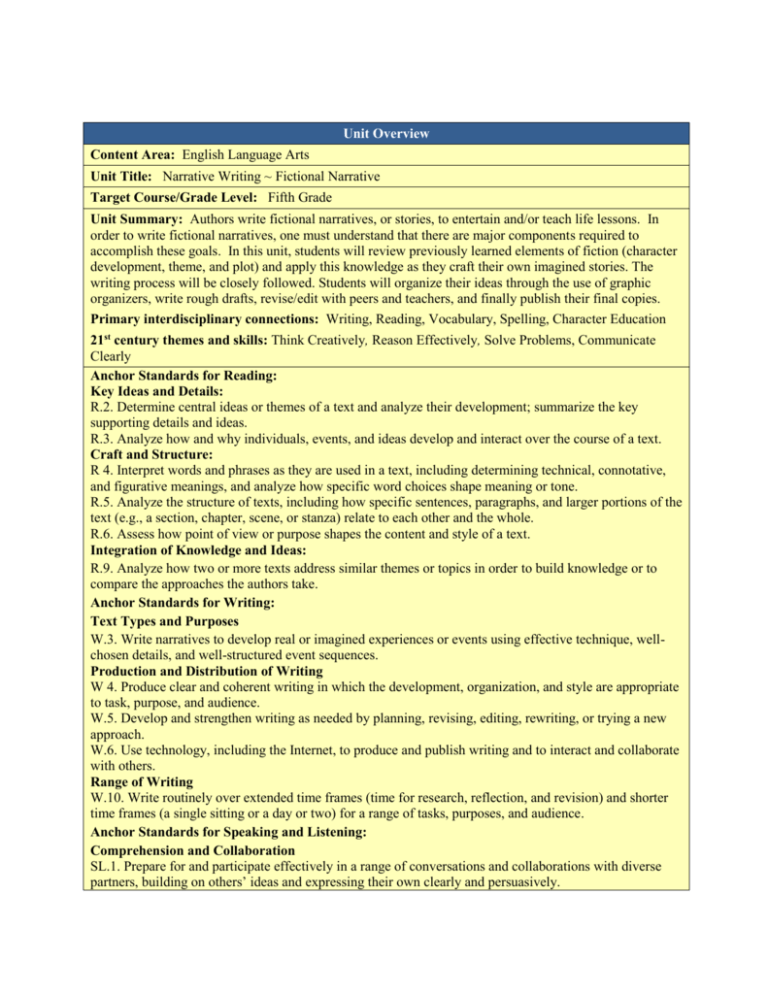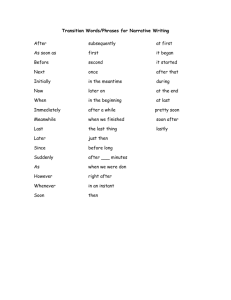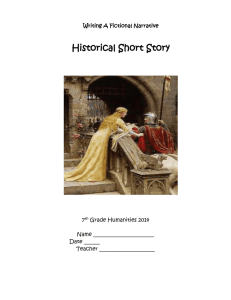Fictional Narrative Writing - Tewksbury Township Schools
advertisement

Unit Overview Content Area: English Language Arts Unit Title: Narrative Writing ~ Fictional Narrative Target Course/Grade Level: Fifth Grade Unit Summary: Authors write fictional narratives, or stories, to entertain and/or teach life lessons. In order to write fictional narratives, one must understand that there are major components required to accomplish these goals. In this unit, students will review previously learned elements of fiction (character development, theme, and plot) and apply this knowledge as they craft their own imagined stories. The writing process will be closely followed. Students will organize their ideas through the use of graphic organizers, write rough drafts, revise/edit with peers and teachers, and finally publish their final copies. Primary interdisciplinary connections: Writing, Reading, Vocabulary, Spelling, Character Education 21st century themes and skills: Think Creatively, Reason Effectively, Solve Problems, Communicate Clearly Anchor Standards for Reading: Key Ideas and Details: R.2. Determine central ideas or themes of a text and analyze their development; summarize the key supporting details and ideas. R.3. Analyze how and why individuals, events, and ideas develop and interact over the course of a text. Craft and Structure: R 4. Interpret words and phrases as they are used in a text, including determining technical, connotative, and figurative meanings, and analyze how specific word choices shape meaning or tone. R.5. Analyze the structure of texts, including how specific sentences, paragraphs, and larger portions of the text (e.g., a section, chapter, scene, or stanza) relate to each other and the whole. R.6. Assess how point of view or purpose shapes the content and style of a text. Integration of Knowledge and Ideas: R.9. Analyze how two or more texts address similar themes or topics in order to build knowledge or to compare the approaches the authors take. Anchor Standards for Writing: Text Types and Purposes W.3. Write narratives to develop real or imagined experiences or events using effective technique, wellchosen details, and well-structured event sequences. Production and Distribution of Writing W 4. Produce clear and coherent writing in which the development, organization, and style are appropriate to task, purpose, and audience. W.5. Develop and strengthen writing as needed by planning, revising, editing, rewriting, or trying a new approach. W.6. Use technology, including the Internet, to produce and publish writing and to interact and collaborate with others. Range of Writing W.10. Write routinely over extended time frames (time for research, reflection, and revision) and shorter time frames (a single sitting or a day or two) for a range of tasks, purposes, and audience. Anchor Standards for Speaking and Listening: Comprehension and Collaboration SL.1. Prepare for and participate effectively in a range of conversations and collaborations with diverse partners, building on others’ ideas and expressing their own clearly and persuasively. Anchor Standards for Language Conventions of Standard English L.1. Demonstrate command of the conventions of standard English grammar and usage when writing or speaking. L.2. Demonstrate command of the conventions of standard English capitalization, punctuation, and spelling when writing. Knowledge of Language L.3. Apply knowledge of language to understand how language functions in different contexts, to make effective choices for meaning or style, and to comprehend more fully when reading or listening. Vocabulary Acquisition and Use L.5. Demonstrate understanding of word relationships and nuances in word meanings. L.6. Acquire and use accurately a range of general academic and domain-specific words and phrases sufficient for reading, writing, speaking, and listening at the college and career readiness level; demonstrate independence in gathering vocabulary knowledge when encountering an unknown term important to comprehension or expression. Learning Targets/Activities Domain: Reading Literature, Writing, Language Cluster: Key Ideas and Details, Craft and Structure, Integration of Knowledge, Text Types and Purposes, Production and Distribution of Writing, Range of Writing, Conventions of Standard English, Knowledge of Language, Vocabulary Acquisition and Use Standard # Standards Write narratives to develop real or imagined experiences or events using effective W.5.3 technique, descriptive details, and clear event sequences. a,b,c,d,e a. Orient the reader by establishing a situation and introducing a narrator and/or characters; organize an event sequence that unfolds naturally. b. Use narrative techniques, such as dialogue, description, and pacing, to develop experiences and events or show the responses of characters to situations. c. Use a variety of transitional words, phrases, and clauses to manage the sequence of events. d. Use concrete words and phrases and sensory details to convey experiences and events precisely. e. Provide a conclusion that follows from the narrated experiences or events. Produce clear and coherent writing in which the development and organization are W.5.4 appropriate to task, purpose, and audience. (Grade-specific expectations for writing types are defined in standards 1–3 above.) W.5.5 With guidance and support from peers and adults, develop and strengthen writing as needed by planning, revising, editing, rewriting, or trying a new approach. W.5.6 W.5.10 RL.5.2 RL.5.3 With some guidance and support from adults, use technology, including the Internet, to produce and publish writing as well as to interact and collaborate with others; demonstrate sufficient command of keyboarding skills to type a minimum of two pages in a single sitting. Write routinely over extended time frames (time for research, reflection, and revision) and shorter time frames (a single sitting or a day or two) for a range of discipline-specific tasks, purposes, and audiences. Determine a theme of a story, drama, or poem from details in the text, including how characters in a story or drama respond to challenges or how the speaker in a poem reflects upon a topic; summarize the text. Compare and contrast two or more characters, settings, or events in a story or drama, RL.5.4 RL.5.5 RL.5.6 RL.5.9 SL.5.1 L.5.1 a,b,c,d,e drawing on specific details in the text (e.g., how characters interact). Determine the meaning of general academic and domain-specific words and phrases in a text relevant to a grade 5 topic or subject area. Explain how a series of chapters, scenes, or stanzas fits together to provide the overall structure of a particular story, drama, or poem. Describe how a narrator’s or speaker’s point of view influences how events are described. Compare and contrast stories in the same genre (e.g., mysteries and adventure stories) on their approaches to similar themes and topics. Engage effectively in a range of collaborative discussions (one-on-one, in groups, and teacher led) with diverse partners on grade 5 topics and texts, building on others’ ideas and expressing their own clearly. a. Come to discussions prepared, having read or studied required material; explicitly draw on that preparation and other information known about the topic to explore ideas under discussion. b. Follow agreed-upon rules for discussions and carry out assigned roles. c. Pose and respond to specific questions by making comments that contribute to the discussion and elaborate on the remarks of others. d. Review the key ideas expressed and draw conclusions in light of information and knowledge gained from the discussions. Demonstrate command of the conventions of standard English grammar and usage when writing or speaking. a. Explain the function of conjunctions, prepositions, and interjections in general and their function in particular sentences. b. Form and use the perfect (e.g., I had walked; I have walked; I will have walked) verb tenses. c. Use verb tense to convey various times, sequences, states, and conditions. d. Recognize and correct inappropriate shifts in verb tense.* e. Use correlative conjunctions (e.g., either/or, neither/nor). L.5.2 a,b,c,d,e Demonstrate command of the conventions of standard English capitalization, punctuation, and spelling when writing. a. Use punctuation to separate items in a series.* b. Use a comma to separate an introductory element from the rest of the sentence. c. Use a comma to set off the words yes and no(e.g., Yes, thank you), to set off a tag question from the rest of the sentence (e.g., It’s true, isn’t it?), and to indicate direct address (e.g., Is that you, Steve?). d. Use underlining, quotation marks, or italics to indicate titles of works. e. Spell grade-appropriate words correctly, consulting references as needed. L.5.3 a,b Use knowledge of language and its conventions when writing, speaking, reading, or listening. a. Expand, combine, and reduce sentences for meaning, reader/listener interest, and style. b. Compare and contrast the varieties of English (e.g., dialects, registers) used in stories, dramas, or poems. L.5.4.c Determine or clarify the meaning of unknown and multiple-meaning words and phrases based on grade 5 reading and content, choosing flexibly from a range of strategies. c. Consult reference materials (e.g., dictionaries, glossaries, thesauruses), both print and digital, to find the pronunciation and determine or clarify the precise meaning of key words and phrases. L.5.5 a,b,c Demonstrate understanding of figurative language, word relationships, and nuances in word meanings. a. Interpret figurative language, including similes and metaphors, in context. b. Recognize and explain the meaning of common idioms, adages, and proverbs. c. Use the relationship between particular words (e.g., synonyms, antonyms, homographs) to better understand each of the words. L.5.6 Acquire and use accurately grade-appropriate general academic and domain-specific words and phrases, including those that signal contrast, addition, and other logical relationships (e.g., however, although, nevertheless, similarly, moreover, in addition). Unit Essential Questions Why do people tell and write imagined stories? How do writers craft engaging, vivid narratives? Unit Enduring Understandings Narratives are carefully structured depictions of diverse human experiences. Time is the main organizational structure of narrative writing. A narrative writer conveys meaning through deliberate use of literary elements and narrative techniques. Unit Learning Targets Students will ... Identify characteristics of a fictional narrative (creative story) by listening to or reading a variety of mentor texts. (RL.5.2, RL.5.3, RL.5.4, RL.5.5, RL.5.6) Identify differences in authors’ approaches to stories read aloud or in groups (RL.5.9) Brainstorm potential topics and narrow focus for their fictional narrative (creative story). (W.5.3) Use an outline or graphic organizer to plan and organize ideas about writing. (W.5.5) Demonstrate the ability to write over various lengths of time, create a fictional narrative establishing a plot or conflict, setting, characters, using a consistent point of view. (W.5.3.a, W.5.10) Follow a plot structure with clear exposition, rising action, climax, falling action, and resolution. (W.5.3.a) Organize narrative writing into paragraphs, and use effective transitions based on changes in action, dialogue, time and place. (W.5.3.c, d; L.5.6) Elaborate main events and ideas by adding thoughts and feelings, dialogue, and description. (W.5.3.b,d; W.5.4) Write a compelling lead and satisfying closing, trying a variety of strategies. (W.5.3.a,e) Using technology, produce a clear published copy of narrative through the use of word processing (W.5.6) Demonstrate the use of figurative language within narrative (L.5.5.a,b) Use vivid verbs and sensory details. (W.5.3.d; L.5.1.c, d; L.5.6) Attempt compositional risks within the narrative. (W.5.3) Receive and incorporate feedback on their writing from their peers and teacher. (W.5.5) Review, revise, and edit their work for sentence construction, spelling, capitalization, punctuation, usage, and clarity. (W.5.5, L.5.1, L.5.2, L.5.3, L.5.4.c) Engage in collaborative small and whole group discussions about narrative writing modeling respected and established expectations. (SL.5.1.a-d) Learning Activities Brainstorm topics Write story following the writing process: - graphic organizer or outline, - rough draft - peer revision/edit - publish revised copy Mini-lessons Crossword puzzle Jigsaw Read alouds of picture books Group reads Independent reads Quick Writes Evidence of Learning Formative Assessments Provide feedback on outline or organizer Comments on fictional narrative drafts Fictional narrative drafts Writing Conferences Anecdotal Records Peer revising/editing conferences Do Now (beginning of class) Exit Cards Classroom discussions Summative Assessments Graded final draft of fictional narrative based on holistic rubric RESOURCES/TECHNOLOGY Teacher Instructional Resources: Mentor texts Picture Books : - Who’s That Knocking on Christmas Eve? by Jan Brett - Aunt Isabel Tells a Good One by Kate Duke - If You Were a Writer by Joan Lowery Nixon - The Plot Chickens by Mary Jane and Herm Auch - Author – a true Story by Helen Lester Graphic Organizers/Outlines EdHelper Lessons that Change Writers, Nancie Atwell 6+ 1 Traits of Writing: The Complete Guide to Writing, Thinking, and Learning by Ruth Culham and Beverly Ann Chin The Writers Express, by Patrick Sebranek, Ruth Nathan, and Dave Kemper Measuring UP Express – speculative prompts Short Story Resources: Treasury of Literature – “Out of This World” Harcourt Brace, Publisher Integration of Technology: SmartBoard ELMO Internet Technology Resources: www.readwritethink.org www.dictionary.com www.thesaurus.com http://tc.readingandwritingproject.com/ http://owl.english.purdue.edu/owl Opportunities for Differentiation: Model the writing process A variety of organizers or outlines Rubrics for written narrative Teacher Notes:






